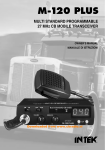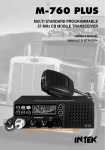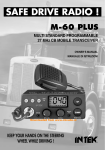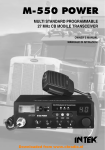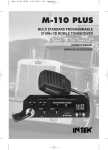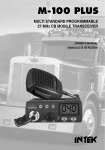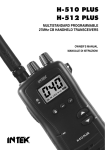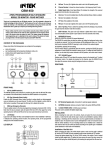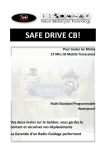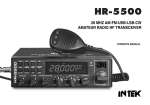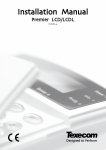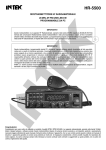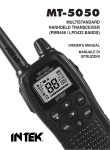Download Man. M-150 PLUS
Transcript
M-150 PLUS MULTI STANDARD PROGRAMMABLE 27 MHz CB MOBILE TRANSCEIVER OWNER'S MANUAL MANUALE DI ISTRUZIONI Declaration of Conformity EC Certificate of Conformity (to EC Directive 99/5-89/336-93/68-73/23) DECLARATION OF CONFORMITY With the present declaration, we certify that the following products : INTEK M-150 PLUS comply with all the technical regulations applicable to the above mentioned products in accordance with the EC Directives 73/23/EEC, 89/336/EEC and 99/5/EC. Type of product : CB Transceiver Details of applied standards : EN 300 433, EN 300 135-2 EN 301 489-1, EN 301 489-13 EN 60065 Manufacturer : INTEK S.R.L. Via G. Marconi, 16 20090 Segrate, Italy Tel. 39-02-26950451 / Fax. 39-02-26952185 E-mail : [email protected] Notified Body : EMCCert Dr. Rasek Boelwiese 5, 91320 Ebermannstadt Germany Identification Number : 0678 Contact Reference : Armando Zanni Tel. 39-02-26950451 / Fax. 39-02-26952185 E-mail : [email protected] Segrate, 31/07/2007 dr. Vittorio Zanetti (General Manager) NOTICE ! It is recommended to carefully read this owner’s manual before using the product. This will also help the user to prevent using the radio in violation of the regulations valid in the country where the product is used, as well as to avoid any possible interferences with other services. 0678 CH RoHS 2002/95/EC Index . . . . . . . . . . . . . . . . . . . . . . . . . . . . . . . . . . . . . . . . . . . . . . . . . . . . . . . . . . . . . . . . . . . . . . . . . . . . . .1 Introduction / Content of the package . . . . . . . . . . . . . . . . . . . . . . . . . . . . . . . . . . . . . . . . . . . . . . . . . . 1 Controls, Indicators and operation . . . . . . . . . . . . . . . . . . . . . . . . . . . . . . . . . . . . . . . . . . . . . . . . . . 2 - 5 Installation . . . . . . . . . . . . . . . . . . . . . . . . . . . . . . . . . . . . . . . . . . . . . . . . . . . . . . . . . . . . . . . . . . . . . . . . 6 Frequency bands table - User Information . . . . . . . . . . . . . . . . . . . . . . . . . . . . . . . . . . . . . . . . . . . . . . 7 Frequency band selection / programming . . . . . . . . . . . . . . . . . . . . . . . . . . . . . . . . . . . . . . . . . . . . . . 8 Table of restrictions on the use of CB transceivers . . . . . . . . . . . . . . . . . . . . . . . . . . . . . . . . . . . . . . . 8 Specifications . . . . . . . . . . . . . . . . . . . . . . . . . . . . . . . . . . . . . . . . . . . . . . . . . . . . . . . . . . . . . . . . . . . . . . 9 Table of restrictions on the use of CB transceivers . . . . . . . . . . . . . . . . . . . . . . . . . . . . . . . . . . . . . . . I VCO Diagram . . . . . . . . . . . . . . . . . . . . . . . . . . . . . . . . . . . . . . . . . . . . . . . . . . . . . . . . . . . . . . . . . . . . . . II PCB - Main Board & Front Board . . . . . . . . . . . . . . . . . . . . . . . . . . . . . . . . . . . . . . . . . . . . . . . . . . III - IV Diagram . . . . . . . . . . . . . . . . . . . . . . . . . . . . . . . . . . . . . . . . . . . . . . . . . . . . . . . . . . . . . . . . . . . . . . .V - VI Block Diagram . . . . . . . . . . . . . . . . . . . . . . . . . . . . . . . . . . . . . . . . . . . . . . . . . . . . . . . . . . . . . . . . VII-VIII NOTICE ! Before using this transceiver, please check that the radio has been programmed on the frequency bands, specifications and operating modes allowed by the regulations valid in the country where the product is used. If not, please proceed to modify the frequency band programming, as it is described in this owner’s manual. This transceiver is factory pre-programmed on the CE European frequency band (CEPT 40CH FM 4W). Congratulations! Congratulations for selecting and purchasing an INTEK quality product. This transceiver includes a number of advanced functions and systems, therefore it is definitely necessary to carefully read this owner’s manual before using the radio. With a correct use of the product in accordance with the operating method described in this manual, the product will offer a trouble free use for many years. INTEK is constantly engaged to develop and provide quality products meeting the customers requirements, however any suggestion or comments on this product that might help us to improve quality are warmly welcome. INTEK M-150 PLUS is a CB transceiver using advanced hardware and software design, it includes a special multi-standard programmable circuit, which allows to program the specifications of the radio (frequency bands, operating modes, transmitter power) in compliance with the regulations valid in the various European countries. Therefore this product can be used in any country of the European Community. The radio is delivered factory pre-programmed on the CE European frequency band (CEPT 40CH FM 4W). Content of the package Please check that all the following items are contained in the packaging : car mounting bracket accessories (hardware, knobs, etc.) microphone bracket owner’s manual main unit (transceiver) DC power cord with fuse holder and fuse condenser microphone car mounting bracket -1- English Index - Introduction - Content of the package Controls, Indicators and operation English Front panel 1 2 3 4 5 6 7 8 9 10 MULTISTANDARD CB RADIO TX AM/FM EMG ANL UK/CEPT RB RX PA M-150 PLUS UP DN OFF/VOLUME 17 16 15 AS/SQUELCH CHANNEL 13 12 14 11 1. AM/FM and UK/CEPT Key AM/FM SELECTOR Shortly press the AM/FM Key (1) to select the AM or FM operating mode in both RX and TX. The AM/FM operating mode selection is possible only if it is allowed the programmed frequency band, otherwise the selection is not possible. UK/CE SELECTOR If the UK (United Kingdom) frequency band has been programmed, press this key for about 2 seconds to select the UK channels/frequencies or the CE channels/frequencies. The channel display will show "U" for the UK channels/frequencies and "C" for the CE channels/frequencies. 2. AM/FM Indicator This green-red dual color LED indicator lights up in green color when radio has been set to the AM (Amplitude Modulation) operating mode and in red color when radio has been set to the FM (Frequency Modulation) operating mode. 3. EMG (Emergency Channels) Key This key allows quick access to one of the two pre-programmed emergency channels (CH9 or CH19). Each time this key is pressed, radio will select CH9, then CH19, then again the normal operating channel. When one of the emergency channels is selected, the LED indicator (4) is lighted. The operating mode (AM or FM) for the emergency channels is factory preprogrammed as per the following table. FREQUENCY BAND ID CODE E1 I2 DE D2 EU CE UK PL CH-9 AM AM AM AM AM FM FM AM CH-19 AM AM AM AM AM FM FM AM -2- 4. EMG Indicator This red color LED indicator is lighted when one of the pre-programmed Emergency Channels has beel selected. 5. ANL Indicator This red color LED indicator is lighted when the ANL (Automatic Noise Limiter) function is enabled. 6. RB Indicator This red color LED indicator is lighted when the Roger Beep function is enabled. 7. LED Display The large size 3-digit LED display indicates the operating channel and the programmed frequency band ID code. 8. TX Indicator This red colour LED indicator lights up when radio is in transmit mode. 9. RX Indicator This red colour LED indicator lights up when radio is in receive mode. 10. Built-in Speaker Built-in front speaker. 11. UP (Up) Key This key allows to select the operating channel upward. By keeping this key pressed, the quick channel selection mode will be enabled. 12. DN (Down) Key This key allows to select the operating channel downward. By keeping this key pressed, the quick channel selection mode will be enabled. 13. AS/SQUELCH Control SQUELCH CONTROL (SQUELCH manual adjustment) The SQUELCH control allows to silent the receiver by cutting the background noise, when no signals are received. Turn the knob clockwise until the background noise is cut. Turn the knob counter clockwise (SQUELCH opening) in order to listen to the weakest signals. AS CONTROL (SQUELCH fixed setting) The AS function allows to automatically silent the receiver, avoding the SQUELCH manual adjustment. A fixed SQUELCH threshold is factory pre-set. To enable the fixed SQUELCH function, turn the knob fully counter clockwise to the AS position, until a click noise is heard. 14. RB Key Press the RB (14) Key to enable the Roger Beep function (automatic beep tone at the end of each transmission). 15. OFF/VOLUME control This knob switches the radio ON and OFF and it adjusts the volume control. If no signals are being received on the operating channel, it is suggested to open the SQUELCH and adjust the volume to the desired level while listening to the background noise. -3- English Controls, Indicators and operation Controls, Indicators and operation English 16. ANL/PA key ANL (Automatic Noise Limiter) FUNCTION Shortly press the ANL/PA (16) key to enable the ANL (Automatic Noise Limiter) function, in order to reduce electric or electromagnetic noise or interference on the used channel. The LED indicator (5) is lighted to confirm that the ANL function is enabled. Press again the ANL /PA(16) key to disable the function. PA (Public Address) CONTROL The radio includes the PA (Public Address) function, in order to spread audio messages through an external speaker. To use the PA function, connect an external speaker (optional) to the PA jack (19) located on the rear side of the radio. Press the ANL/PA (16) key for about 1.5 seconds. The LED display (7) wil show PA. Now it is possible to press the PTT (22) key and speak into the microphone to spread your message through the external speaker. 17. MICROPHONE Connector Connect the supplied condenser microphone to this connector, locking it through the ring nut. Rear Panel 18 ANTENNA 19 20 PA EXT POWER 13.2V DC 21 18. ANTENNA Connector Antenna connector. Refer to the section INSTALLATION OF THE ANTENNA. 19. PA Jack If the PA function has to be used, connect to the external speaker (optional) to this jack. Refer to item no. 16. 20. EXT (External Speaker) Jack This jack is for connecting an external speaker (optional). 21. 13.2VDC POWER CORD 13.2VDC power cord input. -4- English Controls, Indicators and operation Microphone 22 23 22. PTT (Push-to-Talk) Key Transmitter key. Press the PTT (22) key to transmit and release it to return to the receive mode. 23. MICROPHONE Plug 6-pole microphone plug with locking ring nut, to be connected to the microphone connector (17) located on the front side of the radio. WARNING ! Do never try to open the cabinet of the radio. No user serviceable parts are inside the cabinet. Tampering or modifying the circuit of the radio or its original factory adjustment may cause damage to the product, may change the electrical specifications and will void the warranty. If service is required, please refer only to a qualified and authorized service center. -5- Installation English Installation Before installing the main unit in the vehicle, check and select the most convenient location, in order that the radio will be easy to reach and comfortable to operate, without disturbing or interfering with the vehicle drive. Use the supplied bracket and hardware to install the radio. The bracket screws must be well tightened in order not to become loosen with the vehicle vibrations. The car mounting bracket can be installed over or below the radio and the radio may be inclined as desired according to the specific type of installation (under dashboard or track cabin roof installation). Installation of the Main Unit Before connecting the radio to the vehicle electric system, make sure that radio is switched off, with the OFF/VOLUME (15) knob completely turned counter clockwise at OFF position. The DC power cable (21) of the radio is complete with a fuse holder with fuse located on the red positive (+) wire. Connect the DC power cable to the vehicle electric system, with special attention to respect correct polarity, even if the radio is protected against polarity inversion. Connect the red wire to the positive (+) pole and the black wire to the negative (-) pole of the vehicle electric system. Make sure that the wires and terminals are firmly and stably connected, in order to prevent cables from disconnecting or causing short circuits. Installation of the Antenna A specific mobile antenna adjusted for 27 MHz frequency range must be used. The antenna installation must be done by a specialised technician or service centre. Please pay special attention to carefully install the antenna on the vehicle with perfect connection to ground. Before connecting the antenna to the radio, it is necessary to check the correct operation of the antenna with low standing wave ratio (S.W.R.), using adequate instruments. If not, the transmitter circuit of the radio could be damaged. The antenna must be usually installed on the highest part of the vehicle, free from obstacles and as far away as possible from any source of electric or electromagnetic noise. The RF antenna coaxial cable must not be damaged or pressed on its way between antenna and the radio. The correct operation of the antenna and the low standing wave ratio (S.W.R.) must be checked periodically. Connect the RF antenna coaxial cable to the antenna connector (18), located on the rear side of the radio. Checking Operation of the Radio Once radio has been connected to the vehicle electric system and to the antenna, the correct operation of the system may be checked. Please proceed as follows : 1) Check that the power cable is correctly connected. 2) Check that the RF antenna coaxial cable is correctly connected. 3) Connect the microphone to the connector (17), located on the front side of the radio. 4) Rotate the AS/SQUELCH (13) knob counter clockwise. 5) Turn radio on using the OFF/VOLUME (15) knob and adjust volume to the desired level. 6) Select the desired channel, using the UP (11) and DN (12). 7) Rotate the AS/SQUELCH (13) knob clockwise, to cut the background noise. 8) Press the PTT (22) key to transmit and release it to receive. The transceiver will work correctly. -6- Frequency Bands Table The transceiver INTEK M-150 PLUS includes an advanced multi-standard programmable circuit, which allows to program different frequency bands, specifications and operating modes, in conformity with the regulations in the country where the product is used. 8 programmable frequency bands are available, as per the below table : FREQUENCY BAND ID CODE E1 I2 dE d2 EU CE ITALY/SPAIN ITALY GERMANY GERMANY EUROPE/FRANCE CEPT U UK PL POLAND SPECIFICATIONS (Channels, Operating Modes, TX Power) COUNTRY 40CH AM / FM 4W 36CH AM / FM 4W 80CH FM 4W - 12CH AM 1W 40CH FM 4W - 12CH AM 1W 40CH FM 4W - 40CH AM 1W 40CH FM 4W 40CH FM 4W UK FREQUENCIES 40CH FM 4W CEPT FREQUENCIES 40CH AM / FM 4W POLISH FREQUENCIES Attention ! This radio has been factory pre-programmed on the CE frequency band (CEPT 40CH FM 4W), since this standard is currently accepted in all the European countries. Please refer to the information table at page I (Restrictions on the use of CB transceivers). User Information in accordance with art. 13 of the Legislative Decree of 25th July 2005, no. 15 ”Implementation of Directives 2002/95/EC, 2002/96/EC and 2003/108/EC, relative to reduction of the use of hazardous substances in electrical and electronic equipment, in addition to waste disposal”. The crossed bin symbol shown on the equipment indicates that at the end of its working life the product must be collected separately from other waste. The user must therefore take the above equipment to the appropriate differentiated collection centres for electronic and electro technical waste, or return it to the dealer when purchasing a new appliance of equivalent type, in a ratio of one to one. Appropriate differentiated waste collection for subsequent recycling, treatment and environment-friendly disposal of the discarded equipment helps to prevent possible negative environmental and health effects and encourages recycling of the component materials of the equipment. Illegal disposal of the product by the user will be punished by application of the administrative fines provided for by the legislative decree no. 22/1997 (article 50 and following of the legislative decree no. 22/1997). -7- English Frequency bands table - User Information Frequency band selection / Programming English Frequency Band Selection / Programming The radio must be programmed and used exclusively on a frequency band allowed in the country where the product is used. It is possible to program a different frequency band, as per the following procedures : 1) Switch off the radio. 2) Press and hold the UP (11) key while turning on the radio, using the OFF/VOLUME (15) knob. 3) The current programmed frequency ID code will blink on the LED display (7); during the frequency band selection process, the frequency band ID code will blink at a faster speed. 4) Now select the desired new country code, using the UP (11) or DN (12) keys. 5) Press the DN (12) key for about 2 seconds to confirm and store the new selected frequency band ID code. Table of Restrictions on the Use of CB Transceivers (page I) The following information are to be considered only just as an indication. They are believed to be correct at the time of printing this operating manual. It is however the user’s responsibility to check that, in the country where radio is used, the regulations for the use of CB transceivers have not been modified. User is therefore suggested to contact the local dealer or local authority, in order to check the current regulations for the use of CB transceivers, before operating this product. The manufacturer does not take any responsibility if the product is used in violation of the regulations of the country where the product is used. Addendum (Updated information on national restrictions) BELGIUM, UK, SPAIN, SWITZERLAND In order to use this transceiver in Belgium, UK, Spain and Switzerland, residence must have an individual licence. Users coming from abroad may freely use the radio in FM mode, while in order to use it in AM mode they must hold a licence released in their own country. ITALY Foreigners arriving in Italy must get an Italian authorization. AUSTRIA Austria does not allow using multi standard programmable CB radios. It is recommended to carefully follow this directives and not to use the product in the Austrian territory. GERMANY Along some border areas in Germany, the radio can not be used as a base station from channel 41 to channel 80. Refer to local authority (notification office) for details. -8- Specifications General Channels Frequency range Frequency control Operatine temperature DC input voltage Size Weight Refer to the frequency bands table at page 7 27 MHz Citizen Band P.L.L. -10°/+55°C 13.2Vdc ±15% 180 (L) x 50 (A) x 153 (P) mm 950 gr. Receiver System IF Sensitivity Audio output Audio distorsion Image rejection Adjacent channel Signal/noise ratio Current drain Double conversion, CPU controlled super-eterodine 1° 10.695 MHz / 2° 455 KHz 0.5uV for 20dB SINAD (FM) 0.5uV for 20dB SINAD (AM) @10% THD 2.5W at 8 ohm <8% at 1 KHz 65dB 65dB 45dB 325mA (stand-by) Transmitter System Maximum RF power Modulation Impedance Current drain CPU controlled P.L.L. systhesizer 4W at 13.2Vdc 85% to 90% (AM) 1.8 KHz ±0.2 KHz (FM) 50 ohm unbalanced 1300mA (at no modulation) -9- English Specifications Indice - Introduzione - Contenuto della confezione Indice . . . . . . . . . . . . . . . . . . . . . . . . . . . . . . . . . . . . . . . . . . . . . . . . . . . . . . . . . . . . . . . . . . . . . . . . . . . .10 Introduzione / Contenuto della confezione . . . . . . . . . . . . . . . . . . . . . . . . . . . . . . . . . . . . . . . . . . . . . 10 Descrizione dei comandi, indicatori e funzionamento . . . . . . . . . . . . . . . . . . . . . . . . . . . . . . . . . 11-14 Installazione e collegamenti elettrici . . . . . . . . . . . . . . . . . . . . . . . . . . . . . . . . . . . . . . . . . . . . . . . . . . 15 Italiano Tabella bande di frequenza - Avviso agli utenti . . . . . . . . . . . . . . . . . . . . . . . . . . . . . . . . . . . . . . . . . 16 Selezione / programmazione della banda di frequenza . . . . . . . . . . . . . . . . . . . . . . . . . . . . . . . . . . . 17 Tabella delle restrizioni all' uso dei ricetrasmettitori CB . . . . . . . . . . . . . . . . . . . . . . . . . . . . . . . . . . 17 Caratteristiche tecniche . . . . . . . . . . . . . . . . . . . . . . . . . . . . . . . . . . . . . . . . . . . . . . . . . . . . . . . . . . . . 18 Tabella delle restrizioni all' uso dei ricetrasmettitori CB . . . . . . . . . . . . . . . . . . . . . . . . . . . . . . . . . . . I Schema elettrico VCO . . . . . . . . . . . . . . . . . . . . . . . . . . . . . . . . . . . . . . . . . . . . . . . . . . . . . . . . . . . . . . . II Circuito stampato Main Board e Front Board . . . . . . . . . . . . . . . . . . . . . . . . . . . . . . . . . . . . . . . . .III-IV Schema elettrico . . . . . . . . . . . . . . . . . . . . . . . . . . . . . . . . . . . . . . . . . . . . . . . . . . . . . . . . . . . . . . . . . V-VI Schema a blocchi . . . . . . . . . . . . . . . . . . . . . . . . . . . . . . . . . . . . . . . . . . . . . . . . . . . . . . . . . . . . . VII-VIII IMPORTANTE ! Prima di utilizzare la ricetrasmittente, verificare che la stessa sia programmata per operare sulle bande di frequenza e nei modi previsti dalle norme di legge in vigore nel paese in cui la radio viene utilizzata. Diversamente procedere alla modifica della programmazione, come indicato in questo manuale di istruzioni. La radio è preprogrammata all' origine sulla banda di frequenza europea CE (CEPT 40CH FM 4W). Congratulazioni ! Congratulazioni per aver scelto ed acquistato un prodotto di qualità INTEK. Questo ricetrasmettitore dispone di numerose funzioni avanzate e vari dispositivi, pertanto è assolutamente necessario leggere attentamente questo manuale di istruzioni prima di utilizzare l' apparecchio. Con un uso corretto secondo quanto è indicato nel manuale di istruzioni, l' apparecchio garantirà un servizio senza problemi per molti anni. Ci impegnamo costantemente a fornire prodotti di qualità che rispondano alle vostre esigenze, ma siamo comunque sempre molto interessati a ricevere eventuali vostri commenti o suggerimenti su questo prodotto, che ci aiutino nel continuo miglioramento della qualità. INTEK M-150 PLUS è un ricetrasmettitore con caratteristiche tecniche di hardware e software molto avanzate e dispone di un circuito di tipo Multi Standard programmabile che consente di configurare i vari parametri dell' apparecchio (bande di frequenza, modi operativi, potenza del trasmettitore) in modo conforme alle norme di legge in vigore nei vari paesi della Comunità Europea. Pertanto questa ricetrasmittente può essere utilizzata in un qualsiasi paese della Comunità Europea. L' apparecchio viene consegnato pre-programmato sulla banda CE (CEPT 40CH FM 4W). Contenuto della confezione Verificare che le seguenti parti siano contenute nella confezione : ricetrasmettitore cavetto di alimentazione DC con porta fusibile e fusibile microfono electret a condensatore staffa di montaggio per veicolo - 10 - accessori per montaggio staffa (viti, pomelli, ecc.) staffa di supporto per microfono manuale di istruzioni Descrizione dei comandi, indicatori e funzionamento Pannello frontale 2 3 4 5 6 7 8 9 10 Italiano 1 MULTISTANDARD CB RADIO TX AM/FM EMG ANL UK/CEPT RB RX PA M-150 PLUS UP DN OFF/VOLUME 17 16 15 14 AS/SQUELCH CHANNEL 13 12 11 1. Tasto AM/FM - UK/CEPT SELETTORE AM/FM Premendo brevemente questo tasto verrà selezionato il modo operativo AM o FM in ricezione e trasmissione. La selezione del modo AM/FM è abilitata solamente se ammessa dalla banda di frequenza / modo programmata, diversamente la selezione non è possibile. SELETTORE UK/CEPT Se è stata programmata la banda di frequenza UK (Gran Bretagna), mantenendo premuto questo tasto è possibile la selezione tra i canali/frequenze UK (sul display comparirà la lettera U seguita dal numero del canale) e i canali/frequenze CE (sul display comparirà la lettera C seguita dal numero del canale). 2. Indicatore AM/FM Questo indicatore LED luminoso bi-colore rosso-verde è acceso in colore rosso quando il ricetrasmettitore riceve e trasmette in modo FM (modulazione di frequenza) e in colore verde quando il ricetrasmettitore riceve e trasmette in modo AM (modulazione di ampiezza). 3. Tasto EMG (Emergency Channels) Questo tasto permette la selezione rapida di uno dei 2 canali di emergenza pre-programmati (CH9 o CH19). Ad ogni pressione del tasto, viene impostato il canale CH9, quindi il canale CH19, quindi nuovamente il normale canale in uso. Quando è in uso uno dei canali di emergenza, l' indicatore LED (4) è acceso. I canali di emergenza sono predefiniti nei modi AM o FM come dalla seguente tabella : CODICE BANDA DI FREQUENZA E1 I2 DE D2 EU CE UK PL CH-9 AM AM AM AM AM FM FM AM CH-19 AM AM AM AM AM FM FM AM - 11 - Descrizione dei comandi, indicatori e funzionamento 4. Indicatore EMG Questo indicatore LED luminoso di colore rosso è acceso quando è in uso uno dei canali di emergenza. Italiano 5. Indicatore ANL Questo indicatore LED luminoso di colore rosso è acceso quando è abilitato il dispositivo ANL (Automatic Noise Limiter). 6. Indicatore RB Questo indicatore LED luminoso di colore rosso è acceso quando è abilitato il dispositivo Rober Beep (tono di fine trasmissione). 7. LED Display Display a LED a 3-digit, indica il canale in uso e la banda selezionata. 8. Indicatore LED TX Questo indicatore LED luminoso di colore rosso è acceso quando il ricetrasmettitore è in modalità trasmissione. 9. Indicatore LED RX Questo indicatore LED luminoso di colore verde è acceso quando il ricetrasmettitore è in modalità ricezione. 10. Altoparlante incorporato Altoparlante frontale entro contenuto. 11. Tasto UP (Up) Questo tasto permette la selezione dei canali in ordine crescente. Mantenendo premuto questo tasto, la selezione dei canali avverrà in modo rapido. 12. Tasto DN (Down) Questo tasto permette la selezione dei canali in ordine decrescente. Mantenendo premuto questo tasto, la selezione dei canali avverrà in modo rapido. 13. Manopola AS/SQUELCH COMANDO SQUELCH (regolazione manuale SQUELCH) Il comando SQUELCH permette di silenziare il ricevitore, eliminando il rumore (fruscio) di fondo in assenza di segnali. Ruotare la manopola in senso orario sino a quando scompare il rumore di fondo. Ruotare la manopola in senso antiorario (apertura dello SQUELCH) per ascoltare i segnali più deboli. COMANDO AS (regolazione fissa SQUELCH) E' disponibile la funzione AS per silenziare il ricevitore in modo automatico, senza eseguire la regolazione manuale dello SQUELCH. Una regolazione fissa dello SQUELCH è pre-impostata in origine. Per impostare la funzione AS, ruotare la manopola completamente in senso antiorario fino a farla scattare in posizione AS. 14. Tasto RB Premendo questo tasto verrà selezionato il dispositivo Roger Beep (tono di fine trasmissione). 15. Manopola OFF/VOLUME Manopola di accensione e spegnimento della radio. Permette la regolazione del volume di ascolto. In assenza di segnali sul canale in uso, si consiglia di aprire lo SQUELCH e quindi di regolare il volume al livello desiderato utilizzando come riferimento il rumore (fruscio) di fondo. - 12 - 16. Tasto ANL / PA FUNZIONE ANL (Automatic Noise Limiter) Premendo brevemente il tasto ANL (16) viene inserito il dispositivo ANL (Automatic Noise Limiter) che permette la riduzione dei disturbi radio elettrici ed elettromagnetici sul canale in uso. L' indicatore LED (5) sarà acceso a conferma dell' inserimento del dispositivo. Ripremere il tasto ANL/PA (16) per disattivare il dispositivo ANL. COMANDO PA (Public Address) Il ricetrasmettitore dispone della funzione PA (Public Address) per diffondere comunicazioni audio tramite un' altoparlante esterno. Per utilizzare la funzione PA occorre collegare un altoparlante esterno (opzionale) all' apposita presa PA (19) posta sul pannello posteriore della radio. Quindi mantenere premuto il tasto ANL/PA (16) finchè indicazione PA appare sul display (7). Ora è possibile premere il tasto PTT (22) e quindi parlare nel microfono per diffondere la comunicazione tramite l' altoparlante esterno. 17. Presa per microfono Collegare il microfono electret in dotazione a questa presa, bloccandolo tramite l' apposita ghiera. Pannello posteriore 18 ANTENNA 19 20 PA EXT POWER 13.2V DC 21 18. Presa di antenna (SO-239) Presa per il collegamento dell' antenna. Vedi capitolo installazione e collegamenti elettrici.. 19. Presa PA (Public Address) Presa per il collegamento di un altoparlante esterno per la diffusione di messaggi PA (Public Address). Vedi paragrafo n. 16. 20. Presa EXT (External Speaker) Presa per il collegamento di un altoparlante esterno (opzionale). 21. Entrata POWER 13.2VDC Entrata del cavetto di alimentazione DC in dotazione. - 13 - Italiano Descrizione dei comandi, indicatori e funzionamento Descrizione dei comandi, indicatori e funzionamento Microfono 22 Italiano 23 22. Tasto PTT (Push-to-Talk) Tasto di trasmissione. Premere per trasmettere e mantenere premuto durante la trasmissione e rilasciare per ritornare in modalità ricezione. 23. Connettore microfono Connettore del microfono a 6 poli con ghiera di fissaggio, da collegarsi alla apposita presa (17) sul pannello frontale. IMPORTANTE ! Non tentare mai di aprire il contenitore del ricetrasmettitore. All' interno dell' apparecchio non vi sono parti utili o utilizzabili dall' utente. Interventi o manomissioni del circuito interno della radio possono causare danni alla stessa o modificarne le caratteristiche tecniche ed inoltre violano e invalidano il diritto alla garanzia. In caso di interventi tecnici, rivolgersi esclusivamente ad tecnico o ad un centro di assistenza autorizzato. - 14 - Installazione e collegamenti elettrici E' necessario verificare e localizzare sul veicolo la posizione più opportuna ove installare l' apparato, in modo che sia pratico e confortevole l' utilizzo dello stesso e che l' ubicazione del ricetrasmettitore non sia in nessun modo di ostacolo alla guida del veicolo. Per il montaggio del ricetrasmettitore, utilizzare la staffa e le viti in dotazione. Le viti di fissaggio della staffa devono essere ben serrate in modo che le vibrazioni del veicolo non possano allentarle. La staffa può essere montata sia sopra sia sotto l' apparecchio a seconda del tipo di installazione richiesto. Il ricetrasmettitore può anche essere inclinato e poi bloccato nella posizione desiderata tramite i 2 pomelli di fissaggio in dotazione. Collegamento elettrico del ricetrasmettitore Prima di collegare l’ apparecchio al circuito elettrico del veicolo, assicurarsi che il ricetrasmettitore sia spento, ovvero che la manopola OFF/VOLUME (15) sia girata completamente in senso antiorario in posizione OFF. Il cavetto di alimentazione (21) del ricetrasmettitore è completo di porta-fusibile con fusibile di protezione posto sul cavo rosso del positivo (+). Collegare il cavetto di alimentazione al circuito elettrico del veicolo, facendo molta attenzione nel rispettare la corretta polarità, anche se l’ apparecchio è protetto contro le inversioni di polarità. Collegare il cavetto rosso al polo positivo (+) e il cavetto nero al polo negativo (-) del circuito elettrico del veicolo. Assicurasi che il collegamento dei cavetti sia ben eseguito e che i terminali siano ben fissati, per evitare che essi si possano staccare o causare corto circuiti. Installazione e collegamento dell’ antenna Deve essere utilizzata un’ antenna veicolare tarata sulle frequenze CB 27 MHz. L’ installazione dell’ antenna deve essere eseguita da un tecnico specializzato. La massima attenzione deve essere prestata nel montaggio dell’ antenna sul veicolo e nel collegamento della stessa alla massa del veicolo. Prima del collegamento al ricetrasmettitore, è indispensabile che sia verificato il corretto funzionamento dell’ antenna con basso livello di onde stazionarie (R.O.S.), tramite apposita strumentazione. In caso contrario, il circuito trasmittente dell’ apparecchio potrebbe venire danneggiato. L’ antenna deve essere normalmente montata sulla parte più alta del veicolo, libera da ostacoli e il più possibile distante da fonti di disturbo elettrico o elettromagnetico. Il cavetto coassiale RF dell’ antenna non deve essere danneggiato o schiacciato nel percorso dall’ antenna al ricetrasmettitore. La corretta funzionalità dell’ antenna ed il basso rapporto di onde stazionarie (R.O.S.) devono essere controllati periodicamente. Collegare il cavo RF dell’ antenna all’ apposita presa di antenna (18), posta sul pannello posteriore della radio. Controllo del funzionamento del ricetrasmettitore Una volta eseguiti i collegamenti elettrici del cavo di alimentazione e dell’ antenna, si può controllare il corretto funzionamento del sistema. Procedere come segue : 1) Controllare che sia correttamente collegato il cavetto di alimentazione. 2) Controllare che sia correttamente collegato il cavetto coassiale RF dell’ antenna. 3) Collegare il microfono all’ apposita presa (17), posta sul pannello frontale della radio. 4) Ruotare il comando AS/SQUELCH (13) in senso antiorario a inizio corsa. 5) Accendere l’ apparecchio tramite la manopola OFF/VOLUME (15) e regolare il volume di ascolto al livello desiderato. 6) Selezionare il canale desiderato, tramite i tasti UP (11) e DN (12). 7) Ruotare il comando AS/SQUELCH (13) in senso orario, per eliminare il rumore di fondo. 8) Premere il tasto PTT (22) per trasmettere e quindi rilasciarlo per ricevere. Il ricetrasmettitore dovrà funzionare correttamente. - 15 - Italiano Installazione Tabella bande di frequenza - Avviso agli utenti Tabella bande di frequenza Il ricetrasmettitore INTEK M-150 PLUS dispone di un avanzato circuito multi-standard programmabile, che consente di programmare la banda di frequenza, i parametri e i modi operativi in conformità con le norme del paese in cui viene utilizzato l’ apparecchio. Sono disponibili n. 8 bande programmabili, come dalla seguente tabella : Italiano CODICE BANDA DI FREQUENZA E1 I2 dE d2 EU CE ITALIA/SPAGNA ITALIA GERMANIA GERMANIA EUROPA/FRANCIA CEPT U INGHILTERRA PL POLONIA PAESE SPECIFICHE (Canali, modi operativi, potenza TX) 40CH AM / FM 4W 36CH AM / FM 4W 80CH FM 4W - 12CH AM 1W 40CH FM 4W - 12CH AM 1W 40CH FM 4W - 40CH AM 1W 40CH FM 4W 40CH FM 4W FREQUENZE UK 40CH FM 4W FREQUENZE CEPT 40CH AM / FM 4W FREQUENZE POLACCHE Attenzione ! Il ricetrasmettitore è stato pre-programmato all’ origine sulla banda di frequenza con codice paese CE (CEPT 40CH FM 4W), in quanto questo standard è attualmente riconosciuto in tutti i paesi europei. Vedere la tabella delle informazioni alla pag. I (Restrizioni all’ uso dei ricetrasmettitori CB). Avviso agli utenti Ai sensi dell’art. 13 del decreto legislativo 25 luglio 2005, n. 15”Attuazione delle Direttive 2002/95/CE, 2002/96/CE e 2003/108/CE, relative alla riduzione dell’uso di sostanze pericolose nelle apparecchiature elettriche ed elettroniche, nonché allo smaltimento dei rifiuti”. Il simbolo del cassonetto barrato riportato sull’apparecchiatura indica che il prodotto alla fine della propria vita utile deve essere raccolto separatamente dagli altri rifiuti. L’utente dovrà, pertanto, conferire l’apparecchiatura giunta a fine vita agli idonei centri di raccolta differenziata dei rifiuti elettronici ed elettrotecnici, oppure riconsegnarla al rivenditore al momento dell’acquisto di una nuova apparecchiatura di tipo equivalente, in ragione di uno a uno. L’adeguata raccolta differenziata per l’avvio successivo dell’apparecchiatura dismessa al riciclaggio, al trattamento e allo smaltimento ambientalmente compatibile contribuisce ad evitare possibili effetti negativi sull’ambiente e sulla salute e favorisce il riciclo dei materiali di cui è composta l’apparecchiatura. Lo smaltimento abusivo del prodotto da parte dell’utente comporta l’applicazione delle sanzioni amministrative di cui al dlgs. n. 22/1997” (articolo 50 e seguenti del dlgs. n. 22/1997). - 16 - Selezione / programmazione della banda di frequenza Selezione / programmazione della banda di frequenza 2. Premere e mantenere premuto il tasto UP (11), quindi accendere il ricetrasmettitore, ruotando la manopola OFF/VOLUME (15). 3. Il codice di paese impostato lampeggia sul display (7). 4. Selezionare ora il nuovo codice di paese desiderato utilizzando i tasti UP (11) e DN (12); la velocità del lampeggio sarà più rapida ad indicare la procedura di selezione. 5. Premere per circa 2 secondi il tasto DN (12) per confermare. Tabella delle restrizioni all’ uso dei ricetrasmettitori CB (pag. I) Le seguenti informazioni sono date a solo titolo indicativo. Si ritiene che le stesse siano corrette al momento della stampa del presente manuale di istruzioni. E’ tuttavia responsabilità dell’ utilizzatore del ricetrasmettitore il verificare che, nel paese in cui viene utilizzato l’ apparecchio, non siano state introdotte variazioni alle norme di legge che abbiano modificato le suddette restrizioni. Si consiglia quindi l’ utilizzatore di consultare il proprio rivenditore di fiducia o l’ autorità locale al fine di verificare con esattezza le norme di legge in vigore e le restrizioni all’ uso per i ricetrasmettitori CB, prima di utilizzare il prodotto. Il produttore non assume alcuna responsabilità per l’ uso del prodotto in modo non conforme a quanto è stabilito dalle norme di legge, vigenti nel paese in cui il prodotto è utilizzato. Addendum (Aggiornamento sulle restrizioni nazionali) BELGIO, GRAN BRETAGNA, SPAGNA, SVIZZERA Per poter utilizzare questo ricetrasmettitore in Belgio, Gran Bretagna, Spagna e Svizzera, i residenti necessitano di una licenza individuale. Coloro che invece provengono dall’ estero possono utilizzare liberamente l’ apparecchio in modo FM, mentre per utilizzarlo in modo AM devono essere in possesso di una licenza rilasciata dal paese di origine. ITALIA Per gli stranieri che arrivano in Italia, è necessaria una autorizzazione italiana. AUSTRIA L’ Austria non autorizza l’ uso di ricetrasmettitori CB di tipo multi-standard (programmabili). Si consiglia di rispettare scrupolosamente questa direttiva e di non utilizzare l’ apparecchio nel territorio austriaco. GERMANIA Lungo i confini di alcune zone della Germania, l’ utilizzo del ricetrasmettitore come stazione base dal canale 41 al canale 80 non è ammesso. Rivolgersi all’ autorità locale (ufficio notifiche) per ulteriori dettagli. - 17 - Italiano Il ricetrasmettitore deve essere programmato e utilizzato esclusivamente su una banda di frequenza ammessa nel paese in cui viene utilizzato l’ apparecchio. Per programmare la banda di frequenza, eseguire la seguente procedura : 1. Spegnere il ricetrasmettitore. Caratteristiche tecniche Caratteristiche tecniche Generali Italiano Canali Gamma di frequenza Controllo di frequenza Temperatura di lavoro Tensione di alimentazione Dimensioni Peso Vedere tabella bande di frequenza a pag. 16 27 MHz Banda Cittadina P.L.L. -10°/+55°C 13.2Vdc +/-15% 153 (L) x 50 (A) x 180 (P) mm 950 gr. Ricevitore Sistema IF Sensibilità Uscita audio Distorsione audio Reiezione alle immagini Canale adiacente Rapporto segnale/rumore Consumo Super-eterodina a doppia conversione, controllato da CPU 1° 10.695 MHz / 2° 455 KHz 0.5uV per 20dB SINAD (FM) 0.5uV per 20dB SINAD (AM) @10% THD 2.5W a 8 ohm <8% a 1 KHz 65dB 65dB 45dB 325mA (stand-by) Trasmettitore Sistema Potenza RF massima Modulazione Impedenza Consumo Sintetizzatore P.L.L. controllato da CPU 4W a 13.2Vdc da 85% a 90% (AM) 1.8 KHz ±0.2 KHz (FM) 50 ohm sbilanciati 1300mA (senza modulazione) - 18 - Italiano Note - 19 - Table of restrictions on the use of CB transceivers COUNTRY AUSTRIA BELGIUM DENMARK FINLAND FRANCE GERMANY GREECE IRELAND ITALY CB Introd. Use restrictions and other comments NO Not allowed 40 CH - 4W FM - Individual license is required YES 40 CH - 1W AM - Individual license is required YES 40 CH - 4W FM - Free use 40 CH - 4W FM - Free use YES e 1W AM - Free use 40 CH - 4W FM - Free use YES 40 CH - 1W AM - Free use 80 CH - 4W FM - Free use (restrictions for use as a base station on channels 41-80 in some border areas) 12 CH - 1W AM - Free use 40 CH - 1W AM YES Free use (only CH 4-15 allowed) 40 CH - 4W FM - Free use 12 CH - 1W AM - Free use REGTP Vfg41 issued on September 10, 2003 40 CH - 4W FM - Free use YES 40 CH - 4W AM - Free use T/R 20-02 40 CH - 4W FM - Free use 40 CH - 4W AM - Free use YES S.I. No 436 of 1998. WIRELESS TELEGRAPHY ACT, 1926 (SECTION3) (EXEMPTION OF CITIZENS' BAND (CB) RADIOS) ORDER, 1998 YES LUXEMBOURG YES NORWAY YES NETHERLANDS YES PORTUGAL YES UNITED KINGDOM YES SPAIN YES SWEDEN YES SWITZERLAND YES 40 CH - 4W FM - A Declaration to the Italian Ministry is required (art. 145 - dl 259 of 01/08/2003) 40 CH 1W AM - A Declaration to the Italian Ministry is required (art. 145 - dl 259 of 01/08/2003) 34 CH - 4W FM, 1W AM (erp). Nota: AM mode allowed on CH1-CH23 only. General authorisation is required (art. 104 - dl259 of 01/08/2003) P.N.F. issued on DM 08.07.02 Notes: 49 A/B/C/D/E/G 40 CH - 4W FM - Free use. (Following frequencies are not allowed : 29.995, 27.045, 27.095, 27.145, 27.195 MHz) 40 CH - 4W FM - Free use 40 CH - 4W FM - Free use 40 CH - 1W AM - Free use 40 CH - 4W FM - Individual license is required 40 CH - 1W AM - Individual license is required 40 CH - 4W FM - Individual licence is required UK-RA-MPT 1382/MPT1320; UK-R&TTE -S.IL. 2000:730 40 CH - 4W FM - Individual licence is required 40 CH - 4W AM - Individual licence is required Ministerial decree of 18th November 2002 issued by "Secretaría de Estado de Telecomunicaciones y para la Sociedad de la Información" 40 CH - 4W FM - Free use 40 CH - 1W AM - Individual licence is required 40 CH - 4W FM - Individual licence is required 40 CH - 1W AM - Individual licence is required -I- Settings EU CE FR EU FR EU FR CE CE CE DE EU CE D2 CE EU FR SP EU FR I0 SP EU FR I0 CE CE I2 CE EU FR EU FR UK SP CE CE CE CE EU FR EU FR EU FR CE CE CE VCO Diagram - II - PCB - Main Board & Front Board M-150 PLUS / M-760 PLUS - III - PCB - Main Board & Front Board M-150 PLUS / M-760 PLUS - IV - Diagram -V- Diagram - VI - Block Diagram - VII - Block Diagram - VIII - Notes Notes
































